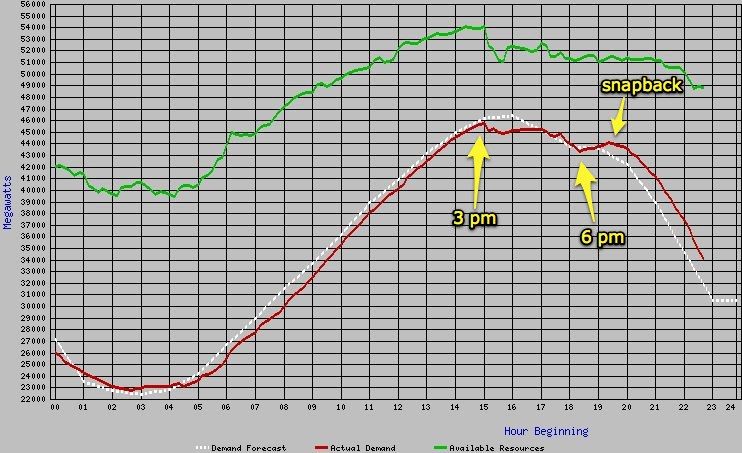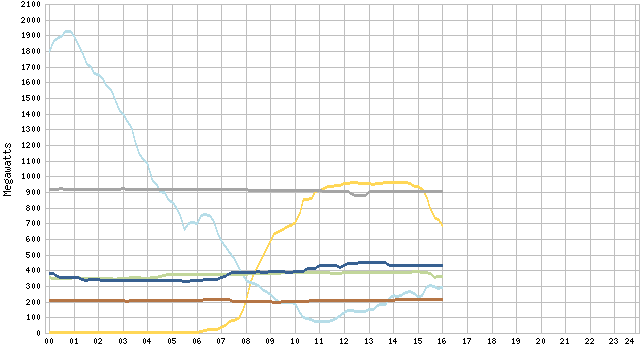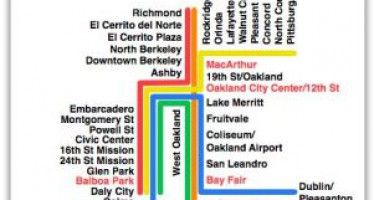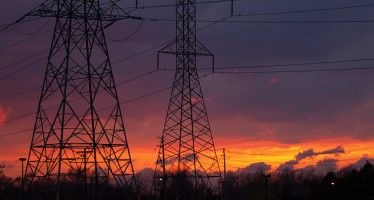Moonbeam power no help during heat wave energy ‘snapback’
Aug. 10, 2012
by Wayne Lusvardi
Green Power hasn’t been much help during the current heat wave. Especially bad have been the “snapback” hours from, about 7 to 8 pm daily, when demand exceeds the forecasted supply of power. Green Power is, at best, a pricey luxury public good.
The state electric grid operator forecasts that California should have a surplus of about 10 percent — or 5,200 megawatts of extra power — to cover the estimated demand of about 47,000 megawatts of electricity needed to meet the heat wave from August 10-12.
But wind and solar power are producing only about 1,300 megawatts — or about 2.8 percent — of peak hour power needs from 3 to 5 p.m. during the heat wave.
And green power can’t be counted on if suddenly the wind should stop blowing or a dust storm should cover solar panels on desert solar energy plants. Despite all the hoopla about Green Power it is a pricey luxury public good ,at best.
Is California’s huge investment in green power — wind and solar energy — making any difference? And when California shifts to 33 percent mandated Green Power in the year 2020, will this pose a threat to the reliability of the power grid during similar heat waves or cold snaps?
Shut Downs and Outages Result in FLEX alert
Contributing to the crisis of the heat wave of the second week in August, 2012, is that the 2,150-megawatt San Onofre Nuclear Power Station is shutdown for repairs and an unidentified 775-megawatt natural gas power plant suddenly went down for unexplained reasons. The San Onofre nuke plant remains offline with no scheduled restart date.
These two facilities roughly serve about 2.95 million homes. This resulted in the state electric grid operator calling a “Flex Alert” to conserve electricity consumption on Thursday August 9 through Sunday August 12. A Flex Alert is meant to prevent having to call a Stage 1 power emergency.
Most of the Flex alert reductions were absorbed by industries reducing their work, closing early, or going to night shifts. Greenies may detest “smokestack” industries but it is mostly such industries that make it so homes can continue to run air conditioning during heat waves.
Green Power Generation on August 9
The three stable sources of green power — geothermal, biomass, and hydropower — were producing about 1,500 megawatts on Aug. 9 (see second graph above).
The variable sources of green power — wind and solar power — were producing about 1,900 megawatts when it was least needed at 1 a.m.
At 8 a.m. wind and solar were generating about 600 to 700 megawatts of power.
At 3 p.m. — when peak power was needed most — wind and solar were only about 1,300 megawatts of the 47,000 megawatt peak load or about 2.8 percent. Solar power production starts to drop fast while consumption is rising towards its peak. This is not typically fatal to irrigating crops but it could be for other purposes.
Then there is the proverbial “snapback” of power demand about 7 to 8 pm. This is when demand typically exceeds forecasted supply of power as people turn on late night television to go to bed but air conditioners are still turned on. Solar power at this hour is typically non-existent and wind power is mostly a late night and early morning phenomenon.
2020 crisis
There is a looming crisis for 2020, when the proportion of green power has to be 33 percent of the base load power sources in California by law. Base load power — the lowest level of power needed in a day — is about 25,000 megawatts on at 5 a.m. for August 10.
When air conditioning, then evening lighting, is added we reach a consumption peak. Peak power is defined as the highest demand required at a particular time. On Aug. 10 that should be about 47,000 megawatts of power per hour.
In 2020, thirty three percent of base load power on a day like August 9 would be about 8,250 megawatts (25,000 megawatts x 33 percent = 8,250 MW’s).
During a similar heat wave in the year 2020, the 8,250 megawatts of green power would equate to about 17.5 percent of total peak hour demand. Today, the state electricity grid operator uses about a 10 percent surplus to meet any unexpected emergency demands on the system.
But what happens in 2020 when highly unreliable Green Power amounts to 17.5 percent of the power mix? What happens when variable Green Power is greater than the backup power? Will California have to add more expensive conventional power plants than it should need to just to have a reliable source of power?
Blackouts have increased 350 percent since 2007.
Hopefully, California will have a chance by 2020 to repeal or curtail its Green Power mandate. But it may take more blackouts such as occurred in San Diego in November 2011 before the proverbial light turns on in the liberal mind of most Californians.
Related Articles
Oil taxes fuel state budget
The group Californians Against Fracking seeks to eliminate oil and gas drilling by hydraulic fracturing methods, called “fracking,” statewide in California. A post-election
Why are costly BART perks ‘little-known’? Media
The Bay Area Rapid Transit System is central to the lives of hundreds of thousands of people and has been
Electricity tier changes, rate hikes bring higher energy costs
With a recently approved proposal to hike electricity rates throughout the state and a new proposal from a local board






